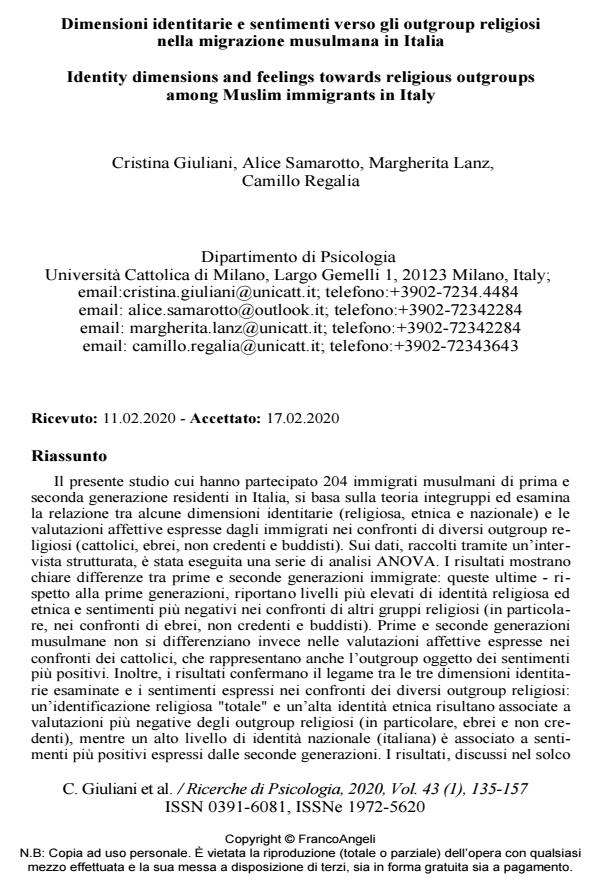Identity dimensions and feelings towards religious outgroups among Muslim immigrants in Italy
Journal title RICERCHE DI PSICOLOGIA
Author/s Cristina Giuliani, Alice Samarotto, Margherita Lanz, Camillo Regalia
Publishing Year 2020 Issue 2020/1
Language Italian Pages 23 P. 135-157 File size 244 KB
DOI 10.3280/RIP2020-001007
DOI is like a bar code for intellectual property: to have more infomation
click here
Below, you can see the article first page
If you want to buy this article in PDF format, you can do it, following the instructions to buy download credits

FrancoAngeli is member of Publishers International Linking Association, Inc (PILA), a not-for-profit association which run the CrossRef service enabling links to and from online scholarly content.
This study conducted among Muslim first and second generation immigrants living in Italy is based on intergroup theory to examine the relationship between three identity dimensions (religious, ethnic, and national) and affective ratings of multiple religious subgroups (Catholics, Jews, non-believers and Buddhists). 204 Muslim immigrants participated in structured interviews, and a series of mixeddesign analysis of variance (ANOVA) was performed. The findings showed clear differences between first and second generation: compared to second generation, the former reported higher levels of religious and ethnic identity and more negative feelings towards other religious groups (in particular, Jews, non-believers, and Buddhists). Muslim first and second generations do not differ in the affective ratings of Catholics. Furthermore, all three identity dimensions were significantly associated with feelings towards religious outgroups: ‘total’ Muslim identification and high ethnic identity were linked to more negative ratings of religious outgroups (Jews, non-believers), while high level of national (Italian) identity was linked to positive feelings towards outgroups among second generations. The results are discussed within the tradition of social identity theory, highlighting the salience of religion as an identity marker for intergroup relationships.
Keywords: Migration, Muslims, identity, religion, religious outgroup.
- Migrazioni e psicologie. Introduzione al Forum Alessandro Antonietti, Antonella Marchetti, in RICERCHE DI PSICOLOGIA 1/2020 pp.13
DOI: 10.3280/RIP2020-001002
Cristina Giuliani, Alice Samarotto, Margherita Lanz, Camillo Regalia, Dimensioni identitarie e sentimenti verso gli outgroup religiosi nella migrazione musulmana in Italia in "RICERCHE DI PSICOLOGIA " 1/2020, pp 135-157, DOI: 10.3280/RIP2020-001007